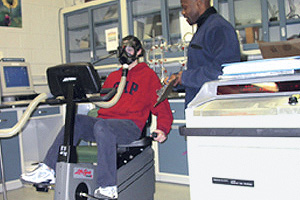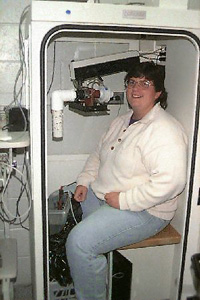Professor Arthur T. Johnson



A number of experimental devices make the Human Performance Laboratory unique. These include a whole-body plethysmograph, spirometer, and ergometer, pulse oximeter, pulmonary function test unit, vision testing equipment, and a treadmill, as well as analytical equipment for measuring carbon dioxide, oxygen and other gases exhaled from human subjects.
Instrumentation that gives valuable teaching experience to undergraduate and graduate biomedical engineers includes a bronchoscope, ultrasonic imaging devices, magnetic and ultrasonic blood flow meters, and a patient health monitoring system.
Developed in the lab, the APD is a new medical instrument used for the noninvasive measurement of respiratory resistance. This device can be very useful for measurements on small children, unconscious or uncooperative patients, and animals. Hundreds of volunteers, including visitors to the lab at the University's annual Maryland Day, have provided the data necessary to make the APD a success.
Since the APD only measures resistance, it is often used in conjunction with the lab's spirometer (see below) to gather data about the strength of the subject's muscles.
Learn more about the airflow perturbation device »
The lab's ergometers provide a physical challenge for test subjects. Their settings allow researchers to quantify the amount of challenge given and identify physical work rate, which is then used to make comparisons between conditions and for standardization.

The "body box" is used to measure the volume of air in the lungs and the resistance to airflow in the airways of the respiratory system, which assists fundamental research on how our lungs work, and aids in the diagnosis and treatment of disease. Results from the airflow perturbation device (APD, see above) are compared to its results to determine the APD's accuracy.
The pulse oximeter indirectly measures the amount (saturation) of oxygen in the blood. It shines a light through a piece the skin, and determines if the blood is red or blue—that is, it detects the oxygen saturation of hemoglobin based on the color. This cannot be accomplished by taking an ordinary blood sample, because the results are altered as soon as the blood comes into contact with air.
The spirometer is a device for measuring volume and pressure of air inspired and expired by the lungs, indicators of pulmonary function. When a subject uses the spirometer over a period of time, researchers or doctors can plot air flow rate vs. flow volume. While in practice this is a standard medical test for patients, small children often find it difficult or stressful since the process requires forceful breathing and direction from a technician. As an alternative, the lab is developing the airflow perturbation device (APD, see above), which requires only normal breathing to measure respiratory resistance.